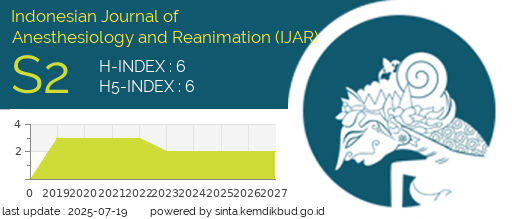A Systematic Review and Meta-Analysis of Paracervical Blocks as A Perioperative Strategy in Reducing Postoperative Pain in Patients Undergoing Laparoscopic Hysterectomy
Downloads
Introduction: Perioperative strategies to reduce postoperative pain are important for enhancing patient satisfaction. However, further research and trials has sparked ongoing debates of various strategies regarding efficacy and safety. Objective: This study aims to improve evidence-based strategies regarding the effect of paracervical anaesthetic blocks in patients undergoing laparoscopic hysterectomy. Methods: A systematic literature search was conducted through PubMed, Google Scholar, and ScienceDirect for RCTs in laparoscopic hysterectomy patients administered paracervical blocks and those given placebos. The quantitative analysis of pooled relative risk and mean difference with a 95% confidence interval were performed using the Review Manager 5.4 software in the random-effects model or fixed-effects model forest plot. Results: Based on four RCTs included in the analysis, there were significant differences in overall postoperative pain scores assessed by VAS (Visual Analogue Scale) [MD = -0.82, 95%CI (-1.47 to -1.06), p = 0.01]. The subgroup analysis also showed significant differences in VAS pain scores at 30 min and 1 hour post-operation [MD = -2.13, 95% CI (-3.09 to -1.16), p = 0.0001] and [MD = -2.55, 95% CI (-4.29 to -0.81), p = 0.004]. However, there were insignificant results in adequate pain control [RR = 7.90, 95%CI (0.39 to 158.67), p = 0.18], length of hospital stay [MD = 0.01, 95%CI (-0.52 to 0.54), p = 0.96], additional analgesics requirement at 24 hours [RR = 0.88, 95%CI (0.55 to 1.39), p=0.58], and perioperative complications [RR = 0.90, 95%CI (0.56 to 1.47), p = 0.68].Conclusion: This meta-analysis provides evidence that the administration of paracervical block in patients undergoing laparoscopic hysterectomy is associated with a reduction of postoperative VAS pain score but not associated with the length of hospital stay, adequate pain control, additional analgesics requirement at 24 hours, and perioperative complications.
Maher DP, Wong W, Woo P, Padilla C, Zhang X, Shamloo B, et al. Perioperative Factors Associated with HCAHPS Responses of 2,758 Surgical Patients. Pain Med (United States). 2015;16(4):791–801.
Choi JB, Kang K, Song MK, Seok S, Kim YH, Kim JE. Pain characteristics after total laparoscopic hysterectomy. Int J Med Sci. 2016;13(8):562–8.
Yuksel S, Serbetcioglu GC, Alemdaroglu S, Yetkinel S, Durdag GD, Simsek E, et al. An analysis of 635 consequetive laparoscopic hysterectomy patients in a tertiary referral hospital. J Gynecol Obstet Hum Reprod [Internet]. 2020;49(1):101645. Available from: https://doi.org/10.1016/j.jogoh.2019.101645
Lirk P, Thiry J, Bonnet MP, Joshi GP, Bonnet F. Pain management after laparoscopic hysterectomy: Systematic review of literature and PROSPECT recommendations. Reg Anesth Pain Med. 2019;44(4):425–36.
Kwack JY, Kwon YS. Immediate postoperative pain control with ropivacaine following laparoscopic-assisted vaginal hysterectomy: A randomized double-blind pilot study. Taiwan J Obstet Gynecol [Internet]. 2018;57(5):654–8. Available from: https://doi.org/10.1016/j.tjog.2018.08.007
Quinn MJ, Kirk N. Differences in uterine innervation at hysterectomy. Am J Obstet Gynecol. 2002;187(6):1515–20.
7. Jain S, Nazir N, Singh S, Sharma S. A prospective randomised controlled study for evaluation of high"‘volume low"‘concentration intraperitoneal bupivacaine for post"‘laparoscopic cholecystectomy analgesia. Indian J Anaesth. 2019;49(4):257–62.
8. Moher D, Shamseer L, Clarke M, Ghersi D, Liberati A, Petticrew M, et al. Preferred reporting items for systematic review and meta-analysis protocols (prisma-p) 2015 statement. Japanese Pharmacol Ther. 2015;4(1):1–9.
Ouzzani M, Hammady H, Fedorowicz Z, Elmagarmid A. Rayyan-a web and mobile app for systematic reviews. Syst Rev [Internet]. 2016;5(1):1–11. Available from: http://dx.doi.org/10.1186/s13643-016-0384-4
Sterne JAC, Savović J, Page MJ, Elbers RG, Blencowe NS, Boutron I, et al. RoB 2: A revised tool for assessing risk of bias in randomised trials. BMJ. 2019;366:1–8.
Higgins JPT, Thomas J, Chandler J, Cumpston M, Li T, Page MJ, et al. Cochrane handbook for systematic reviews of interventions. Cochrane Handbook for Systematic Reviews of Interventions. 2019. 1–694 p.
Grzesh RLB, Treszezamsky AD, Fenske SS, Rascoff LG, Moshier EL, Ascher-Walsh C. Use of paracervical block before laparoscopic supracervical hysterectomy. J Soc Laparoendosc Surg. 2018;22(3).
Radtke S, Boren T, Depasquale S. Paracervical Block as a Strategy to Reduce Postoperative Pain after Laparoscopic Hysterectomy: A Randomized Controlled Trial. J Minim Invasive Gynecol [Internet]. 2019;26(6):1164–8. Available from: https://doi.org/10.1016/j.jmig.2018.12.001
Noor N, Roy KK, Zangmo R, Das A, Rai R, Kumari A, et al. Role of para-cervical block in reducing immediate postoperative pain after total laparoscopic hysterectomy: a prospective randomized placebo-controlled trial. Obstet Gynecol Sci. 2021;64(1):122–9.
Lee SH, Kim TJ, Lee NH, Jeong SY, Lee J, Song T. Paracervical block in laparoscopic hysterectomy for postoperative pain control: a randomized, multi-center, double-blind, placebo-controlled trial. Clin Exp Obstet Gynecol. 2022;49(3).
Copyright (c) 2023 Rifaldy Nabiel, Daniel Alexander Suseno, Yonas Hadisubroto, Taufiq Gemawan, Aurellia Nuraini, Syadza Salsabila, Eprila Darma

This work is licensed under a Creative Commons Attribution-ShareAlike 4.0 International License.
Indonesian Journal of Anesthesiology and Reanimation (IJAR) licensed under a Creative Commons Attribution-ShareAlike 4.0 International License.
1. Copyright holder is the author.
2. The journal allows the author to share (copy and redistribute) and adapt (remix, transform, and build) upon the works under license without restrictions.
3. The journal allows the author to retain publishing rights without restrictions.
4. The changed works must be available under the same, similar, or compatible license as the original.
5. The journal is not responsible for copyright violations against the requirement as mentioned above.


















